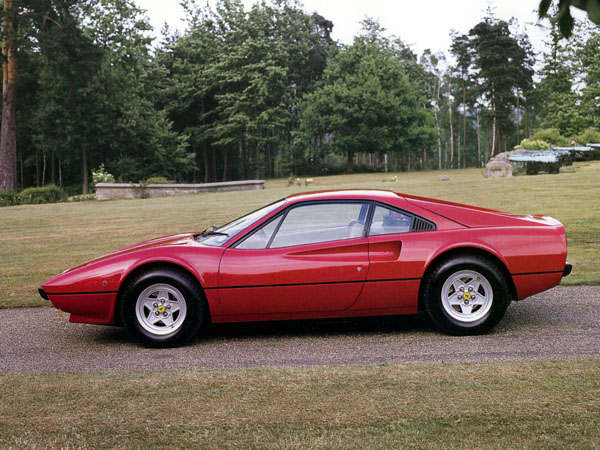The Ferrari 308 GTB is an obvious descendent of the brilliant 246 Dino and its square-rigged replacement, the 308 GT4, adopting the same nomenclature for the engine: 3.0-litre, eight-cylinder, initially with a dry-sump. Bertone was used as a stylist for the four-seater but, for the GTB, Ferrari went back to Pininfarina, which devised a clever update of the Dino theme on a GT4 floorpan, shortened by 210 mm to give the same 2340 mm wheelbase as the Dino, and retaining the transverse alloy four-cam V8. The first 200 cars were built from fibreglass before reverting to steel outer panels, as ever by Scaglietti. The chassis was in a steel tubular form.
It was gorgeous – stubby, brawny and elegant all at the same time. There was not a bad line to the car, not a bad angle to view it from, unless you counted the sail panels from side-on. The GTB retained the Dino’s swoops and curves as well as the trademark side ducts, one for the intake and one for the oil cooler, but interpreted them with a more muscular, updated form for the 80s.
What is interesting about this car is that it first appeared in 1975 and survived as the 328 until 1989, to be replaced by the unloved 348. Inside, the car showed its age with a Dino-esque interior. The controls for heater sliders and lights had survived from the Dino and Daytona.
It had comfortable slim bucket streets and a high steering wheel which was offset to the left as well as pedals set somewhere near the middle of the car. This rather odd positioning meant that drivers had to twist their body sideways to drive the GTB!
On the dashboard is an array of Veglia Borletti instruments, grouped tightly in a binnacle ahead of the wheel, and the spindly light wiper and indicator stalks reminded one of those on the Austin 1100. First time entrants also found it hard to locate the door handles inside this Ferrari as they were under the fronts of the door pulls. There was a perception of room in the 308 but it was strange that it came with air conditioning because the centre of the car was wide open.
To drive the 308 required a certain amount of skill, just to change gears could provide a bit of a challenge. This Ferrari had an open gate which required a very professional approach. The driver needed to be firm and depress the clutch fully for a slick and fast change but later models were modified to make it an easier operation. Reverse just needed a push down against a spring detent. Ventilated disc brakes were fitted all round behind the cast alloy wheels. A top speed of 250km/h was claimed.










